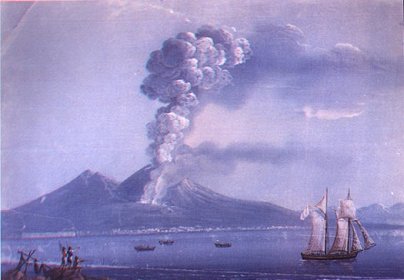
August 24
VESUVIUS DAY



The residents of Pompeii, Herculaneum and Stabiae woke up this morning in 0079 and went about their normal chores. There was no reason for them to fear the mountain whose slopes they farmed. They lived in the shadow of Mt. Vesuvius, overlooking the Bay of Naples, Italy. But, about noon, without any warning, Mt. Vesuvius exploded. Vesuvius, the volcano, erupted, spewing stones and lava, burying Pompeii under 13 feet of ash, and covering Herculaneum and Stabiae with mud and debris. Most of the Romans were buried alive, the layers of volcanic ash preserving them and the remains of Pompeii. The story of this fateful day began to unfold for later generations when archaeologists first uncovered an outer wall of Pompeii in 1748. 2,000 skeletons were eventually uncovered in the Pompeiian ruins, but no one really knows how many thousands more people died from the choking, poisonous fumes and suffocating ash.
There were eye-witness accounts of the tragedy. Pliny the Elder, a natural historian, was commander of the Roman fleet at the time of the eruption. He sailed across the Bay of Naples to get a closer look at the volcanic activity and to rescue survivors. Unable to make any rescues, he was probably overcome by the gaseous fumes and died. Those who had accompanied him gave first-hand reports to Pliny the Elder’s nephew, Pliny the Younger, who wrote two letters outlining, in vivid detail, the events of this day.
Mt. Vesuvius, the peaceful, beautiful mountain, that made its first appearance as a volcano on this day in 79 A.D., is still considered an active volcano.

Those Were the Days, the Today in History service from 440 International
No portion of these files may be reproduced without the express, written permission of 440 International Inc.